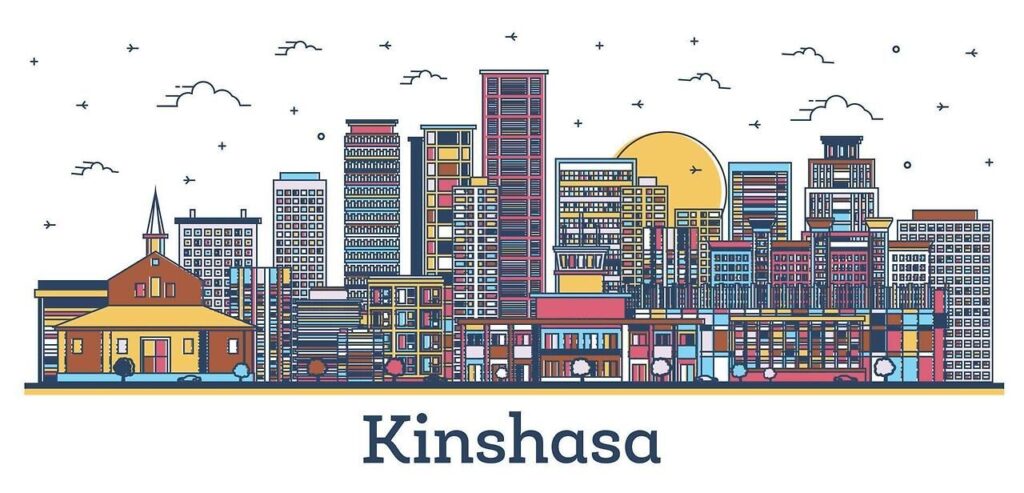
Kinshasa is a major city with a population of approximately 17.78 million, ranking among the top large cities globally and the fourth largest in Africa.
1. City Overview
- Population: As of 2025, the metropolitan area population is estimated at 17.78 million, with an annual growth rate of approximately 4.4%.
- Area: The metropolitan area covers approximately 9,965 km², while the densely populated urban core is about 150 km².
- Languages: The official language is French, and Lingala is used as a common language in Congo, on the streets, and by the general public.
- Religion: Predominantly Christian, with Catholicism and Protestantism as central faiths, and a minority presence of Muslims.
- Climate: Equatorial climate, characterized by consistently high temperatures throughout the year with distinct wet and dry seasons.

2. History
- Early Settlement & Colonial Period (~19th Century): It was originally established as the colonial capital, Léopoldville, by Belgian explorer Stanley in 1881.
- Post-Independence & City Renaming (1960–1966): Following independence in 1960, Belgian influence persisted until the city was renamed Kinshasa in 1966.
- Rapid Growth as a Modern Megacity (1970–Present): The city experienced significant population and urban expansion, evolving into a cultural hub. It was designated a UNESCO Creative City (Music City).
3. Geography
- Location: Situated on the southern bank of the Congo River, directly opposite Brazzaville, the capital of the Republic of Congo.
- Topography: The average elevation is 300 meters, featuring a mixed landscape of plains and low mountains.
- Administrative Divisions: Comprises 24 communes (administrative districts), with a mixed structure of rural and urban areas within the metropolitan region.

4. Culture
- Music Hub: Known as the birthplace of Congolese Rumba, with a vibrant music ecosystem including classical Congolese symphony.
- Linguistic Fusion: A blend of French and Lingala is prominent, shaping its street culture.
- Cultural Spaces: Diverse social activities thrive at locations like the National Museum and street markets (e.g., Zando Central Market).
5. Environment
- Challenges: The city faces significant issues such as a lack of public transport, waste management problems, and flooding.
- Flood Risk: Severe damage occurs during river overflows and heavy late-summer rainfall.
- Response Efforts: Initiatives are underway to secure urban green spaces and improve parts of the transportation network.
6. Economy
- Economic Role: Kinshasa serves as the political, economic, and financial center of the Democratic Republic of Congo.
- Industrial Composition: The city’s economy is primarily driven by manufacturing, telecommunications, finance, healthcare, and education.
- Financial Infrastructure: The ‘Kinshasa Financial Center’ was completed in 2023.

7. Key Locations
- Administrative & Financial Hubs:
- Boulevard du 30 Juin: A central axis with dense administrative and financial districts.
- Kinshasa Financial Center: The largest financial complex in Congo, completed in 2023.
- Cultural & Market Spaces:
- Kinshasa Central Market (Zando): A historic market spanning 72.5 hectares with 35,000 shops.
- Limete Tower: A national monument completed in 2022.
- Urban Landscape:
- Gombe District: A high-density area with affluent residences, and a central hub for diplomatic and government activities.
8. Conclusion
Kinshasa is one of the fastest-growing megacities in Africa.
- Strengths: Its vibrant music culture, status as a political and financial center, and international standing.
- Challenges: Infrastructure deficits, environmental problems, and urban management issues.
- Future Strategies:
- Expansion of public transport and road networks.
- Development of green spaces and flood mitigation infrastructure.
- Strengthening a mixed financial and cultural development model.
- Expanding the Creative Cities Network and improving citizens’ quality of life.
